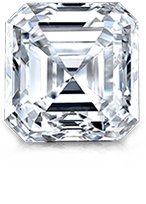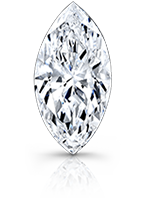- Home >
- All About Shapes


ALL ABOUT
SHAPES
Shape is an expression of personal style. You’re as unique as the stone you’ll wear and this is your first step toward finding your perfect sparkling match. Diamonds speak to our emotions and it’s important for you to settle on the shape that you like best. We’ll let you in on a little secret of the trade… They’re all gorgeous so no matter what you choose you’ll be in great shape!

ROUND BRILLIANT
As the saying goes, “If it ain’t broke… Don’t fix it.” The 58 facet Round Brilliant diamond was conceived by legendary Polish diamond cutter, Marcel Tolkowsky. In his 1919 work, Diamond Design, he systematical analyzed the optics of a diamond and hypothesized as to the perfect shape to achieve maximum fire and brilliance. Guess what? He got it right.
The 20-year-old University of London engineering student’s work is still the benchmark of an industry nearly 100 years after its publication. In the closing sentence of the book, Tolkowsky irreverently opined, “That some new shape will be evolved which will cause even greater fire and life than the brilliant is, of course, always possible, but it appears very doubtful, and it seems likely that the brilliant will be supreme for, at any rate, a long time yet.” Over fifty percent of all diamonds in existence are cut into Round Brilliants.

CUSHION
The cushion cut represents the first true evolution in modern diamond cutting. Its faceting was based on the ‘old mine cut,’ a square stone with rounded corners, a high crown, and 58 large facets. This style was popular in the early 18th century amongst noble classes in Europe.
The modern cushion is arranged with 64 facets for better light reflection and reached the height of its popularity in the early 20th century. An elegantly simple blending of old and new this cut has experienced a recent revival amongst vintage enthusiasts and nostalgic brides-to-be. Some of the most famous diamonds in the world bear the cushion shape including the Hope Diamond (45.52 cts), The Regent Diamond (140.5 cts), and The Yellow Tiffany Diamond (128.54 cts). Around five percent of diamonds purchased are cushion cuts.

PRINCESS
Originally called the ‘Square Modified Brilliant,’ (Yea, we like ‘princess better too) this is a relatively modern shape developed in the 1960’s. It was designed to fulfill a desire for a squared stone that rivaled the modern round brilliant in terms of light production.
The sharp facets on the pavilion of a princess cut are known as chevrons. These chevrons produce a stylish silhouette that draws the gaze toward the center of the stone where the fire burns brightest. Nearly 30 percent of diamonds are of the Princess cut variety.

EMERALD
A member of the step-cut family of shapes, the emerald rose to prominence in the art deco period after World War I. As a result, emerald shaped diamonds bear a striking resemblance to the timeless angular buildings erected during the period.
Today’s emeralds bear 58 facets, 25 resting on the pavilion, 25 on the crown, and 8 on the girdle comprising the signature ‘steps’ for which they’re known. It’s important to select a high clarity when seeking an emerald cut because the large table allows for maximum visibility inside the diamond. Around four percent of diamonds sold are emerald shaped.

RADIANT
Similar to the princess shape, the Radiant diamond possesses a squared design however its corners are cut into sharp 45 degree angles.
Designed by Henry Grossbard in 1977, the radiant was developed in order to preserve the style but maximize the light disbursement of a traditional step-cut style like the emerald shape. It is a true union of the old and the new bearing characteristics of both the modern brilliant style and the classic step-cut. Nearly three percent of today’s diamonds are fashioned in this shape.

OVAL
A member of the brilliant family this shape is the brainchild of Russian born diamond cutter, Lazare Kaplan. At an early age he became an expert in the early technique of ‘cleaving’ a rough diamond.
This is the process by which a large rough stone was split with a single blow by hand to produce two smaller stones of more appealing proportions. In the 1960’s he began working closely with his uncle Abraham Tolkowsky, whose father Marcel created the modern round brilliant. It was this marriage of minds that birthed the scintillating shape known as the oval. Just over three percent of diamonds are shaped in the oval standard.

PEAR
One of the oldest shapes in existence today the pear was first cut in the early 15th century and bears a likeness to the fruit for which it’s named.
A Flemish jeweler and cutting revolutionary named Lodewyk van Berken is responsible not only for this timeless shape but also for inventing the diamond ‘Scaif,’ a polishing wheel infused with diamond dust and olive oil. Without this innovation the art of cutting could never have progressed to where it is today. The 68 carat ‘Taylor-Burton’ diamond given by actor Richard Burton to his wife Elizabeth Taylor is just one of the famous pear shaped stones that color its rich history. Just over two percent of diamonds are pear shaped.

ASSCHER
Another member of the step-cut family, the Asscher is characterized by cropped corners and a less elongated look than its emerald counterpart.
This historic cut bears the namesake of its designer, Joseph Asscher of the Royal Asscher Diamond Company in Amsterdam. It was the first diamond shape ever to be patented and was produced exclusively by Royal Asscher from 1901 until World War II. The Asscher Company was responsible for cutting The Excelsior (997 cts) in 1903, and the largest diamond ever found, The Cullinan (3,106 cts) in 1907, which became the pride of Great Britain’s storied Crown Jewels. In today’s market, Asscher shaped diamonds account for less than two percent of supply.

MARQUISE
This 18th century shape of Royal upbringing was commissioned by the infamous, “Sun King,” Louis XIV. His record 72-year rule of France is defined by extravagance, which truly knew no bounds.
Legend has it that he asked his royal jewelers to produce a diamond that embodied the brilliance of his mistress, the Marquise de Pompadour’s beautiful smile. On its side the 56-facet Marquise does bear a striking resemblance to a smile. Less than one percent of diamonds are shaped in the Marquise style.

HEART
Although it bears the hallmarks of modern faceting, the Heart shape boasts a long and storied history having adorned the fingers of some of the most famous women in antiquity. They were first mentioned by the infamous Duke of Milan in 1463, but were likely first crafted decades earlier. Mary Queen of Scots gifted a ring featuring a heart shaped diamond to Queen Elizabeth. Because they are exceptionally difficult to cut and polish these gems were exchanged almost exclusively by royalty until the 1800’s. The modern heart consists of 59 expertly placed facets and symmetry of the upmost importance with this shape. Hearts currently account for less then 1% of the market but rise in popularity as Valentine’s Day nears.


